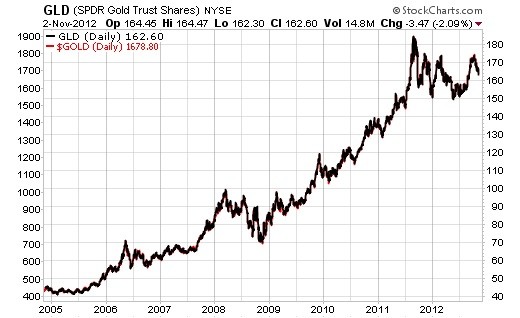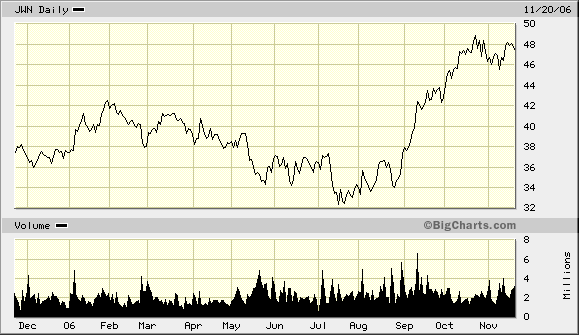ETF Pricing Glossary
Post on: 2 Июнь, 2015 No Comment

- ETF Values. Net Asset Value (NAV), Intraday Value (IOPV/IIV)
- ETF Market Pricing. Trading at a Discount or Premium, Closing Market Price, Bid-Ask Price, Bid-Ask Ratio
- Table of Key Terms
ETF Values
Net Asset Value (NAV). An ETF’s NAV—like the NAV for a mutual fund—is its per share value based on the closing prices of its underlying securities. An ETF’s NAV is calculated daily, using the same standard formula used for valuing mutual fund shares:
NAV = (asset value – liabilities)
number of shares outstanding
ProShares NAVs are used to evaluate their day-to-day performance versus their benchmarks. Investors should not expect to buy or sell ProShares ETFs at NAV. To find the latest NAV and NAV calculation time for any ProShares ETF, click on the fund you are interested in on the Product page .
NAV Calculation Time. The NAVs for most ETFs are calculated at 4:00 p.m. ET, when equity markets close. The NAVs for some ETFs, however, are calculated at other times, based on the time their benchmark prices are set. The NAVs for Short Fixed Income ProShares, for example, are calculated at 3:00 p.m. ET, when bond markets close. NAV calculation times are noted on each ProShares ETF product page.
Intraday Value: Also called Indicative Optimized Portfolio Value (IOPV) or Intraday Indicative Value (IIV) The intraday value is a real-time estimate of an ETF’s fair value, based on the most recent prices of its underlying securities. Because intraday values are generally published by the exchanges every 15 seconds, they should closely approximate the value of an ETF’s holdings. Investors should not expect to buy or sell an ETF at its intraday value. This value simply helps investors gauge if an ETF’s current market price is in line with the value of the ETF’s holdings, or if it’s trading at a discount or premium. Intraday values are available on many quote services (see Finding ProShares Intraday Value ).
ETF Market Pricing
ETF market prices are the prices at which investors buy or sell shares of an ETF. While ETFs are designed to trade in line with their intraday values, during times of significant market volatility an ETF’s market price may vary more widely from its intraday value.

Trading at a Discount or Premium. ProShares generally trade close to their approximate intraday values, but they can trade at a premium or discount due to the forces of supply and demand. ProShares cannot predict or control how closely an ETF will trade to its intraday value.
Premiums and discounts are expressed as a percentage of an ETF’s intraday value. For example, if an ETF’s intraday value is $10 and it’s selling for $10.10, it’s trading at a 1% premium to its intraday value. Similarly, if the ETF is selling for $9.90, it’s trading at a 1% discount to its intraday value.
ETFs Can Trade at a Premium/Discount
Closing Market Price. An ETF’s closing market price is the recorded price of its last trade of the day, and can be found online. The closing price can be set before or after the NAV calculation. Moreover, although the closing price is often close to the NAV, it may be different. In highly volatile markets, this difference may be exaggerated. Note that daily NAV is used to track ProShares’ day-to-day performance, not closing price. To find closing market prices of any ProShares ETFs, click on the Products link at the top of the screen, then select the fund you are interested in from the list.
Bid-Ask Price. Similar to stocks, an ETF’s bid price is the highest price a buyer is willing to pay for an ETF in the open market at any given time during the trading day. Likewise, an ETF’s ask price is the lowest price a seller is willing to accept for an ETF at any point during the day. The difference between an ETF’s current bid and ask price is its spread. When you buy or sell an ETF, you implicitly pay one-half of the ETF’s bid-ask spread as part of your transaction cost.
Bid-Ask Ratio. The bid-ask ratio is a common measure used by investors to compare spreads among different ETFs. It expresses the bid-ask spread as a percentage of the ETF’s total price:
Bid ask ratio = (bid price – ask price)
ETF price
An ETF’s bid-ask ratio can be calculated over any period. An average bid-ask ratio for a month, for example, would divide the month’s average bid-ask spread divided by the month’s average ETF price.
Key Terms
Understanding the differences between ETF valuation and pricing terms can help you better evaluate the performance of your ETF investments.














